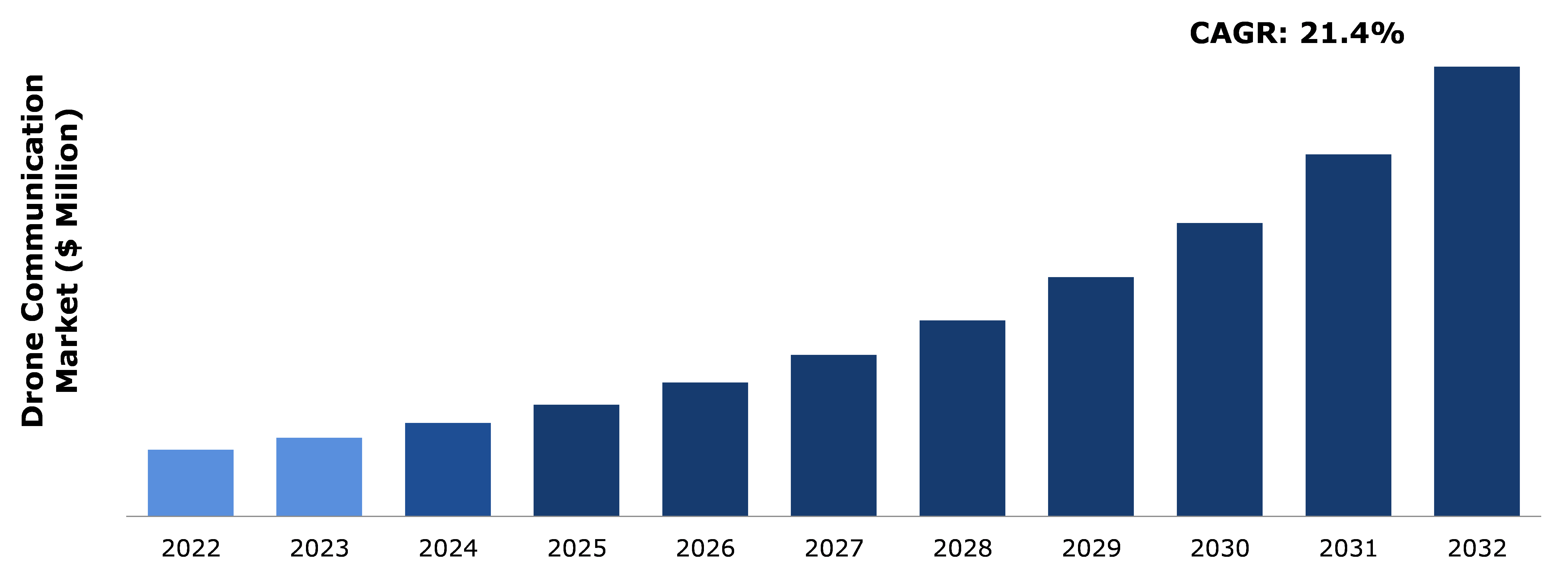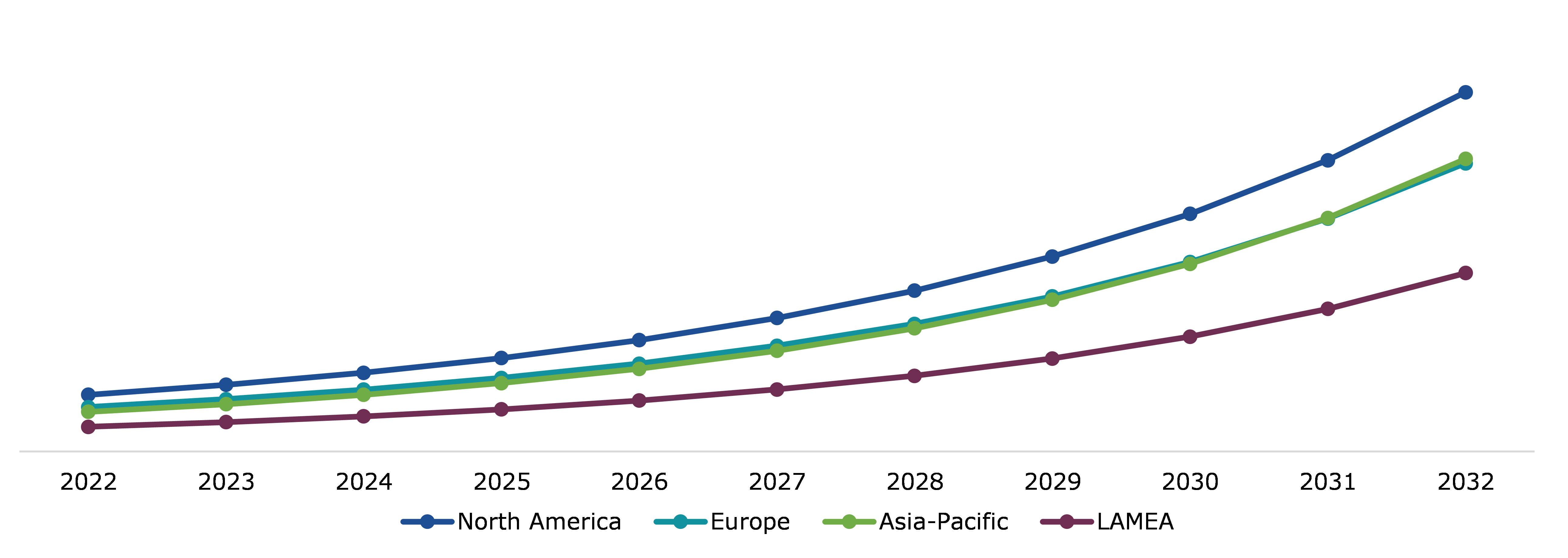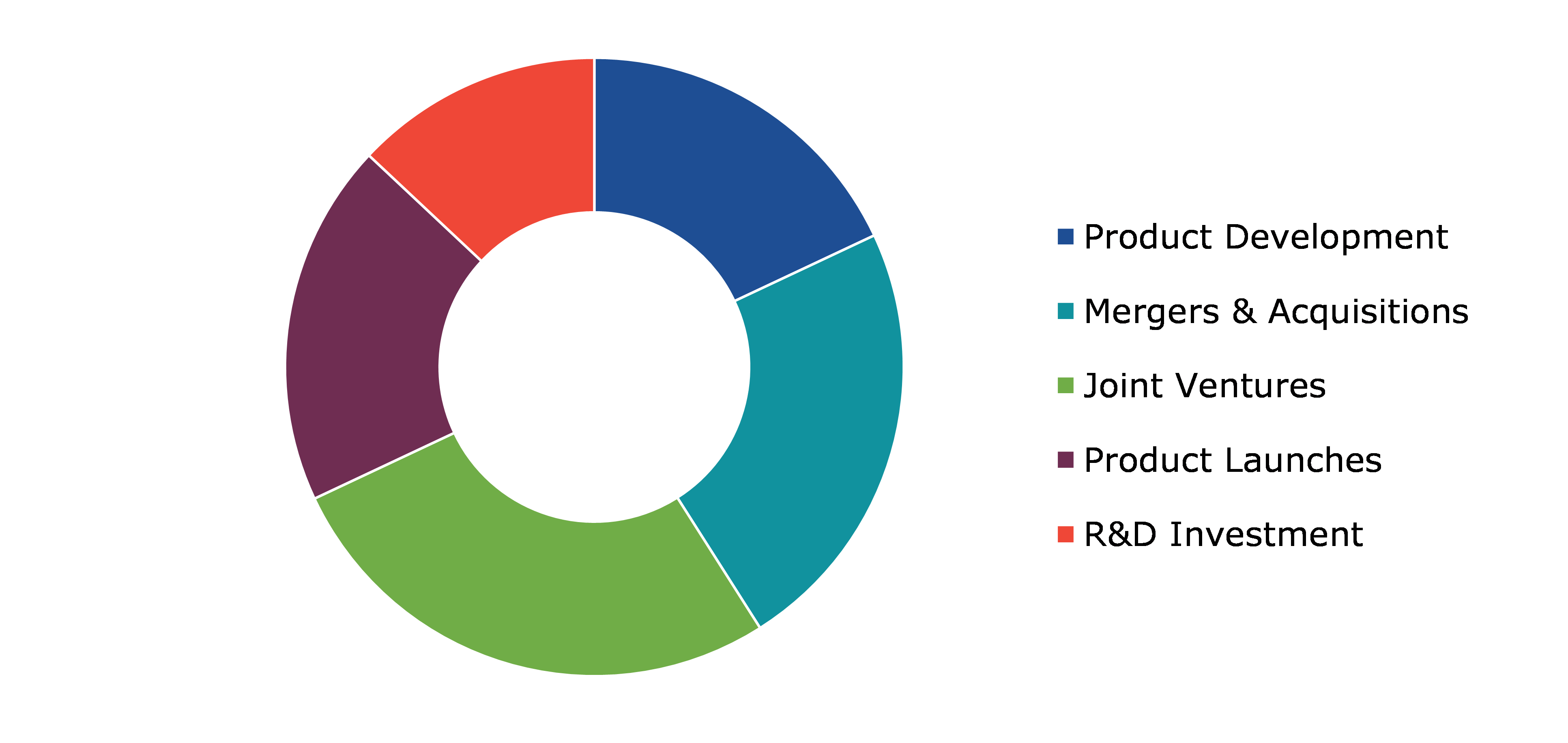Drone Communication Market Report
RA09217
Drone Communication Market by Method (Radio Frequency, Single or Multi Sim, LTE/4G, Satellite, and 5G), Application (Agriculture, Construction & Mining, Inspection, Oil & Gas, and Others), and Region (North America, Europe, Asia-Pacific, and LAMEA): Global Opportunity Analysis and Industry Forecast, 2023-2032
Drone Communication Overview
Drone communication represents a dynamic and rapidly evolving field that addresses the connectivity challenges associated with unmanned aerial vehicles. These challenges include ensuring high throughput, extended communication range, and enhanced coverage for efficient operations. Drones can be configured to collaboratively provide services and extend network coverage by acting as relays in traditional communication networks. The degree of mobility of a drone is dependent upon its application and flying configurations, offering opportunities for performance enhancement through dynamic adjustments to adapt to diverse communication environments.
Drones are not only involved in data transmission but also play a vital role in distributing critical information at the network's edge. They are auxiliary in deploying Long-Term Evolution (LTE) networks in remote locations, showcasing their multifaceted capabilities. Researchers are actively exploring aspects of drone communication, with a specific focus on developing robust, high-capacity communication systems to meet the demands of the evolving landscape. As the field of drone communication and networking continues to grow, drones are anticipated to become more prevalent.
Global Drone Communication Market Analysis
The global drone communication market size was $2,332.0 million in 2022 and is predicted to grow with a CAGR of 21.4%, by generating a revenue of $15,759.9 million by 2032.
Source: Research Dive Analysis
Growing Demand for Drone Communication in the Military & Aerospace Sector to Drive the Market Growth
The drone communication industry is driven by several factors that highlight the significance of Unmanned Aerial Vehicles (UAVs) in various fields, particularly in military settings. This growth is majorly owing to growing security concerns and vulnerabilities of UAVs to security attacks. For instance, the vulnerability of UAVs to security attacks, including jamming, information leakage, and spoofing, highlights the critical need for robust security protocols. Security concerns drive the development and implementation of secure communication systems to protect against unauthorized access, malicious control, and other potential threats. In addition, in the military scenario, addressing security gaps in UAV communication becomes imperative.
The need for secure communication channels between UAVs and Ground Control Stations (GCS) is crucial for maintaining confidentiality, integrity, mutual authentication, and non-repudiation. This requirement drives advancements in communication protocols tailored for military environments. Furthermore, UAVs offer dynamic mobility, quick reaction times, and ease of deployment, making them ideal for various applications at a viable expense. The ability of UAVs to quickly adapt to changing scenarios and provide real-time information drives the demand for efficient and secure communication systems. These factors are anticipated to boost the drone communication market growth in the upcoming years.
High Cost of Satellite & Cellular Technology and Limitation of Spectrum to Restrain the Market Growth
The use of satellite or cellular technology for long-range communication in drones incurs significant costs. The expenses are influenced by factors such as the available spectrum and network activity. These costs act as a restraint, particularly in scenarios where budget constraints limit the widespread adoption of advanced communication technologies. In addition, the architectural design of current drone communications faces challenges related to the varying speeds of drones based on their applications, potentially leading to link distortions. In such cases, efficient routing protocols are essential for effective communication, addressing the need to route packets from source to destination while optimizing the path.
In addition, conserving energy for energy-starved drones is crucial to enhance the network's lifespan. Furthermore, the lack of well-established standards and protocols for drone communication is a significant restraint. The absence of industry-wide guidelines can lead to interoperability issues and hinder seamless communication between different drone systems. These factors are anticipated to restrain the drone communication market revenue growth in the upcoming years.
Advanced Surveying Solutions and Enhanced Safety Protocols to Drive Excellent Opportunities
The growing emphasis on safety in various industries creates an opportunity for the development and enhancement of drone communication infrastructure. Investing in robust communication networks for drones is crucial for real-time data transmission, ensuring effective planning, monitoring, and maintenance. In addition, the integration of drone communication systems with safety protocols and emergency response mechanisms is projected to create several growth opportunities in the drone communication market. Drones equipped with communication capabilities are utilized for swift communication during emergencies, enhancing overall safety preparedness and responsiveness. Furthermore, growing applications of drone communication for monitoring and surveillance purposes is anticipated to drive market expansion. In addition, the companies that provide drone-based monitoring services for large worksites, ensuring efficient progress tracking without compromising worker safety are becoming quite popular. The demand for real-time video feeds and data analytics for improved decision-making is growing rapidly, which is anticipated to generate excellent opportunities in the market during the forecast period.
Global Drone Communication Market Share, by Method, 2022
Source: Research Dive Analysis
The satellite sub-segment accounted for the highest market share in 2022. Satellite communication is a widely used method for drone communication owing to its long-range communication facility and unparalleled global coverage. This is because satellite communication provides unparalleled global coverage, making it a vital component for drone operations in remote and inaccessible areas where traditional ground-based communication infrastructure is unavailable. This is particularly crucial for applications such as environmental monitoring, surveillance, and disaster response in remote regions.
In addition, drones engaged in missions requiring extended operational ranges, such as maritime surveillance or border patrols, benefit significantly from satellite communication. Satellite links enable long-range communication, allowing drones to operate seamlessly across vast expanses where ground-based networks may not provide adequate coverage. Also, satellite communication ensures uninterrupted connectivity for drones in challenging environments where terrestrial communication may face limitations. This is especially valuable in scenarios such as deep-sea exploration, polar regions, or dense forests where maintaining a reliable connection is paramount for mission success. These factors are predicted to boost the popularity of satellite communication methods in the drone industry during the forecast period.
Global Drone Communication Market Share, by Application, 2022
Source: Research Dive Analysis
The agriculture sub-segment accounted for the highest market share in 2022. Drone communication is instrumental in enhancing the efficiency of precision agriculture practices. Drones equipped with advanced sensors and imaging technologies can capture high-resolution data about crop health, soil conditions, and water levels. Real-time communication allows farmers to make data-driven decisions, optimize resource allocation, and respond promptly to changing agricultural conditions. In addition, drone communication facilitates precision farming techniques, enabling farmers to reduce operational costs. By precisely targeting areas that require intervention, such as irrigation or pesticide application, drones contribute to resource optimization.
The ability to quickly survey large agricultural plots without the need for extensive manpower leads to significant cost savings. In addition, drones improve safety standards in agriculture by minimizing the need for manual labor in tasks such as crop monitoring, mapping, and data collection. Farmers can access critical information without exposing themselves to potential hazards or challenging terrains. This not only ensures the safety of farmworkers but also contributes to overall risk reduction. These factors are driving the demand for drone communication in the agriculture sector.
Global Drone Communication Market Size & Forecast, by Region, 2022-2032 ($Million)
Source: Research Dive Analysis
The North America drone communication market generated the highest revenue in 2022. This growth is majorly owing to increase in the number of registered drones in the U.S., due to which there is a growing need for effective communication systems to ensure regulatory compliance and enhance safety measures. Drone communication solutions facilitate communication between drones and air traffic control, ensuring safe airspace management and compliance with aviation regulations. In addition, rise in commercial drone applications, particularly in industries like agriculture, construction, and infrastructure, is driving the demand for robust communication systems.
Drones utilized for tasks such as crop monitoring, surveying, and infrastructure inspections require reliable communication to transmit real-time data and operate efficiently. In addition, technological advancements in the U.S. drone industry such as the launch of drones with longer flight ranges, higher payloads, and improved sensors, drive the need for advanced communication systems to support these capabilities. As drones become more sophisticated, the demand for enhanced drone communication technologies is increasing at a rapid rate. These factors are anticipated to boost the North America drone communication market share in the upcoming years.
Competitive Scenario in the Global Drone Communication Market
Product launch, partnership, and business expansion are common strategies followed by major market players. For instance, on January 17, 2024, Elsight Ltd, the leading provider of drone connectivity solutions, announced the launch of halo drone communication system. This halo drone communication system is a significant advancement in the drone industry owing to its enhanced efficiency and reduced cost of operating drones without the need for changing modems for varying cellular communication providers.
Source: Research Dive Analysis
Some of the leading drone communication market players are DJI, Parrot Drone SAS, AeroVironment, Inc., Yuneec, Skydio, Inc., AgEagle Aerial Systems Inc, Draganfly Innovations Inc., Teal Drones, Microdrones, and Freefly Systems.
| Aspect | Particulars |
| Historical Market Estimations | 2020-2021 |
| Base Year for Market Estimation | 2022 |
| Forecast Timeline for Market Projection | 2023-2032 |
| Geographical Scope | North America, Europe, Asia-Pacific, and LAMEA |
| Segmentation by Method |
|
| Segmentation by Application |
|
| Key Companies Profiled |
|
Q1. What is the size of the global drone communication market?
A. The size of the global drone communication market was $2,332.0 million in 2022 and is projected to reach $15,759.9 million by 2032.
Q2. Which are the major companies in the drone communication market?
A. DJI, Parrot Drone SAS, AeroVironment, Inc., Yuneec, and Skydio, Inc. are some of the key players in the global drone communication market.
Q3. Which region, among others, possesses greater investment opportunities in the future?
A. Asia-Pacific possesses great investment opportunities for investors in the future.
Q4. What will be the growth rate of the Asia-Pacific drone communication market?
A. The Asia-Pacific drone communication market is anticipated to grow at 22.4% CAGR during the forecast period.
Q5. What are the strategies opted by the leading players in this market?
A. Partnership, product launch, and business expansion are the key strategies opted by the operating companies in this market.
Q6. Which companies are investing more on R&D practices?
A. Draganfly Innovations Inc., Teal Drones, Microdrones, and Freefly Systems are the companies investing more on R&D activities for developing new products and technologies.
1. Research Methodology
1.1. Desk Research
1.2. Real time insights and validation
1.3. Forecast model
1.4. Assumptions and forecast parameters
1.5. Market size estimation
1.5.1. Top-down approach
1.5.2. Bottom-up approach
2. Report Scope
2.1. Market definition
2.2. Key objectives of the study
2.3. Market segmentation
3. Executive Summary
4. Market Overview
4.1. Introduction
4.2. Growth impact forces
4.2.1. Drivers
4.2.2. Restraints
4.2.3. Opportunities
4.3. Market value chain analysis
4.3.1. List of raw material suppliers
4.3.2. List of manufacturers
4.3.3. List of distributors
4.4. Innovation & sustainability matrices
4.4.1. Technology matrix
4.4.2. Regulatory matrix
4.5. Porter’s five forces analysis
4.5.1. Bargaining power of suppliers
4.5.2. Bargaining power of consumers
4.5.3. Threat of substitutes
4.5.4. Threat of new entrants
4.5.5. Competitive Rivalry Intensity
4.6. PESTLE analysis
4.6.1. Political
4.6.2. Economical
4.6.3. Social
4.6.4. Technological
4.6.5. Legal
4.6.6. Environmental
4.7. Impact of COVID-19 on drone communication market
4.7.1. Pre-covid market scenario
4.7.2. Post-covid market scenario
5. Drone Communication Market Analysis, by Method
5.1. Overview
5.2. Radio Frequency
5.2.1. Definition, key trends, growth factors, and opportunities
5.2.2. Market size analysis, by region, 2022-2032
5.2.3. Market share analysis, by country, 2022-2032
5.3. Single or Multi Sim
5.3.1. Definition, key trends, growth factors, and opportunities
5.3.2. Market size analysis, by region, 2022-2032
5.3.3. Market share analysis, by country, 2022-2032
5.4. LTE/4G
5.4.1. Definition, key trends, growth factors, and opportunities
5.4.2. Market size analysis, by region, 2022-2032
5.4.3. Market share analysis, by country, 2022-2032
5.5. Satellite
5.5.1. Definition, key trends, growth factors, and opportunities
5.5.2. Market size analysis, by region, 2022-2032
5.5.3. Market share analysis, by country, 2022-2032
5.6. 5G
5.6.1. Definition, key trends, growth factors, and opportunities
5.6.2. Market size analysis, by region, 2022-2032
5.6.3. Market share analysis, by country, 2022-2032
5.7. Research Dive Exclusive Insights
5.7.1. Market attractiveness
5.7.2. Competition heatmap
6. Drone Communication Market Analysis, by Application
6.1. Overview
6.2. Agriculture
6.2.1. Definition, key trends, growth factors, and opportunities
6.2.2. Market size analysis, by region, 2022-2032
6.2.3. Market share analysis, by country, 2022-2032
6.3. Construction & Mining
6.3.1. Definition, key trends, growth factors, and opportunities
6.3.2. Market size analysis, by region, 2022-2032
6.3.3. Market share analysis, by country, 2022-2032
6.4. Oil & Gas
6.4.1. Definition, key trends, growth factors, and opportunities
6.4.2. Market size analysis, by region, 2022-2032
6.4.3. Market share analysis, by country, 2022-2032
6.5. Inspection
6.5.1. Definition, key trends, growth factors, and opportunities
6.5.2. Market size analysis, by region, 2022-2032
6.5.3. Market share analysis, by country, 2022-2032
6.6. Others
6.6.1. Definition, key trends, growth factors, and opportunities
6.6.2. Market size analysis, by region, 2022-2032
6.6.3. Market share analysis, by country, 2022-2032
6.7. Research Dive Exclusive Insights
6.7.1. Market attractiveness
6.7.2. Competition heatmap
7. Drone Communication Market, by Region
7.1. North America
7.1.1. U.S.
7.1.1.1. Market size analysis, by Method, 2022-2032
7.1.1.2. Market size analysis, by Application, 2022-2032
7.1.2. Canada
7.1.2.1. Market size analysis, by Method, 2022-2032
7.1.2.2. Market size analysis, by Application, 2022-2032
7.1.3. Mexico
7.1.3.1. Market size analysis, by Method, 2022-2032
7.1.3.2. Market size analysis, by Application, 2022-2032
7.1.4. Research Dive Exclusive Insights
7.1.4.1. Market attractiveness
7.1.4.2. Competition heatmap
7.2. Europe
7.2.1. Germany
7.2.1.1. Market size analysis, by Method, 2022-2032
7.2.1.2. Market size analysis, by Application, 2022-2032
7.2.2. UK
7.2.2.1. Market size analysis, by Method, 2022-2032
7.2.2.2. Market size analysis, by Application, 2022-2032
7.2.3. France
7.2.3.1. Market size analysis, by Method, 2022-2032
7.2.3.2. Market size analysis, by Application, 2022-2032
7.2.4. Spain
7.2.4.1. Market size analysis, by Method, 2022-2032
7.2.4.2. Market size analysis, by Application, 2022-2032
7.2.5. Italy
7.2.5.1. Market size analysis, by Method, 2022-2032
7.2.5.2. Market size analysis, by Application, 2022-2032
7.2.6. Rest of Europe
7.2.6.1. Market size analysis, by Method, 2022-2032
7.2.6.2. Market size analysis, by Application, 2022-2032
7.2.7. Research Dive Exclusive Insights
7.2.7.1. Market attractiveness
7.2.7.2. Competition heatmap
7.3. Asia-Pacific
7.3.1. China
7.3.1.1. Market size analysis, by Method, 2022-2032
7.3.1.2. Market size analysis, by Application, 2022-2032
7.3.2. Japan
7.3.2.1. Market size analysis, by Method, 2022-2032
7.3.2.2. Market size analysis, by Application, 2022-2032
7.3.3. India
7.3.3.1. Market size analysis, by Method, 2022-2032
7.3.3.2. Market size analysis, by Application, 2022-2032
7.3.4. Australia
7.3.4.1. Market size analysis, by Method, 2022-2032
7.3.4.2. Market size analysis, by Application, 2022-2032
7.3.5. South Korea
7.3.5.1. Market size analysis, by Method, 2022-2032
7.3.5.2. Market size analysis, by Application, 2022-2032
7.3.6. Rest of Asia-Pacific
7.3.6.1. Market size analysis, by Method, 2022-2032
7.3.6.2. Market size analysis, by Application, 2022-2032
7.3.7. Research Dive Exclusive Insights
7.3.7.1. Market attractiveness
7.3.7.2. Competition heatmap
7.4. LAMEA
7.4.1. Brazil
7.4.1.1. Market size analysis, by Method, 2022-2032
7.4.1.2. Market size analysis, by Application, 2022-2032
7.4.2. UAE
7.4.2.1. Market size analysis, by Method, 2022-2032
7.4.2.2. Market size analysis, by Application, 2022-2032
7.4.3. South Africa
7.4.3.1. Market size analysis, by Method, 2022-2032
7.4.3.2. Market size analysis, by Application, 2022-2032
7.4.4. Saudi Arabia
7.4.4.1. Market size analysis, by Method, 2022-2032
7.4.4.2. Market size analysis, by Application, 2022-2032
7.4.5. Rest of LAMEA
7.4.5.1. Market size analysis, by Method, 2022-2032
7.4.5.2. Market size analysis, by Application, 2022-2032
7.4.6. Research Dive Exclusive Insights
7.4.6.1. Market attractiveness
7.4.6.2. Competition heatmap
8. Competitive Landscape
8.1. Top winning strategies, 2022
8.1.1. By strategy
8.1.2. By year
8.2. Strategic overview
8.3. Market share analysis, 2022
9. Company Profiles
9.1. DJI
9.1.1. Overview
9.1.2. Business segments
9.1.3. Product portfolio
9.1.4. Financial performance
9.1.5. Recent developments
9.1.6. SWOT analysis
9.2. Parrot Drone SAS
9.2.1. Overview
9.2.2. Business segments
9.2.3. Product portfolio
9.2.4. Financial performance
9.2.5. Recent developments
9.2.6. SWOT analysis
9.3. AeroVironment, Inc.
9.3.1. Overview
9.3.2. Business segments
9.3.3. Product portfolio
9.3.4. Financial performance
9.3.5. Recent developments
9.3.6. SWOT analysis
9.4. Yuneec
9.4.1. Overview
9.4.2. Business segments
9.4.3. Product portfolio
9.4.4. Financial performance
9.4.5. Recent developments
9.4.6. SWOT analysis
9.5. Skydio, Inc.
9.5.1. Overview
9.5.2. Business segments
9.5.3. Product portfolio
9.5.4. Financial performance
9.5.5. Recent developments
9.5.6. SWOT analysis
9.6. AgEagle Aerial Systems Inc
9.6.1. Overview
9.6.2. Business segments
9.6.3. Product portfolio
9.6.4. Financial performance
9.6.5. Recent developments
9.6.6. SWOT analysis
9.7. Draganfly Innovations Inc.
9.7.1. Overview
9.7.2. Business segments
9.7.3. Product portfolio
9.7.4. Financial performance
9.7.5. Recent developments
9.7.6. SWOT analysis
9.8. Teal Drones
9.8.1. Overview
9.8.2. Business segments
9.8.3. Product portfolio
9.8.4. Financial performance
9.8.5. Recent developments
9.8.6. SWOT analysis
9.9. Microdrones
9.9.1. Overview
9.9.2. Business segments
9.9.3. Product portfolio
9.9.4. Financial performance
9.9.5. Recent developments
9.9.6. SWOT analysis
9.10. Freefly Systems
9.10.1. Overview
9.10.2. Business segments
9.10.3. Product portfolio
9.10.4. Financial performance
9.10.5. Recent developments
9.10.6. SWOT analysis
Personalize this research
- Triangulate with your own data
- Request your format and definition
- Get a deeper dive on a specific application, geography, customer or competitor
- + 1-888-961-4454 Toll - Free
- support@researchdive.com






